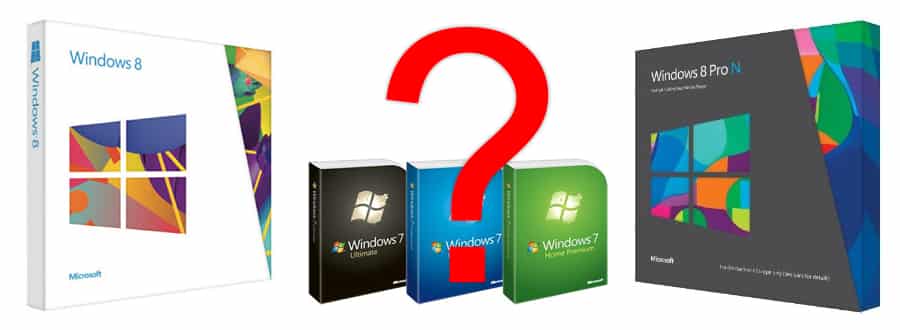After a long wait Microsoft has officially launched Windows 8 operating system last week. So far, we have covered many tutorials and tips for Windows 8, but we had not talked about why one should or should not upgrade from ones current Windows version. From a very personal point of view, here are some of the most important aspects to consider when you choose to stay with you current Windows version or upgrade to the new Windows 8.
Why one should upgrade to Windows 8?
Price: Upgrading to Windows 8 is significantly cheaper compared to the cost of upgrade to previously released Windows versions. To take a concrete example, Windows 7 Home Edition was priced at $199, while the Professional version came for $299 after these were released. With the promotions that Microsoft is currently offering, one can upgrade to Windows 8 from $14.99. The highest amount one has to pay right now to upgrade to Windows 8 Pro is $ 69.99, and this is only if you want to have the installation disk with the box. Online upgrade through the default Windows upgrade process will cost just $39.99. These promotions will, however, be valid till January 31, 2013.
App Store: Thanks to the Windows Store, it will be much easier to find and download Windows 8 applications to our computers. At the moment, the Windows Store has about 6,000 applications. But this number will surely grow in the coming months. Personally, I have no doubt that we will see many interesting things in the store front within a short-term.
Native applications for popular file types: Windows 8 includes options for viewing all popular file formats that previously required installing new applications. For example, the new version of Windows comes with its own PDF viewer, and it is no longer necessary to install Adobe Reader. Also, as we have seen in one of our tutorials it is also possible to mount ISO and VHD files directly from the operating system and make them available as individual drives without problems.
Design and User Interface: With Windows 8 we are getting a new UI called Metro. Although many people agree that Microsoft didn’t make a good move by redesigning Windows environment so drastically, many Windows application developers will have much less pain porting their apps across many device, giving their users more freedom to enjoy using them no matter which Windows 8 device they have. One thing is sure, users who have touch screen displays are certainly going to enjoy this new redesign, while others will have to get used to it.
History files: With Windows 8 it is possible to maintain a historical record of the files one uses every day. With this option one can retrieve documents to a previous state. This option is not entirely new though. In fact, it is as same as Windows backup, but with more and better features as well as being much more user-friendly.
Synchronization in the Cloud: Many of the applications and services we use daily stores data in the cloud to keep all our devices in sync (e.g. our web browser bookmarks). This is an issue that certainly has positively changed the way we work and communicate. Considering this, Microsoft has added cloud based synchronization features to Windows 8.
Why one shouldn’t upgrade to Windows 8?
Microsoft account is almost mandatory: To use all the features available inside Windows 8 you will need to have a Microsoft account (until recently, a Windows Live account). Although you can use Windows 8 without one of these accounts some of crucial apps requires this.
Upgrading from Windows XP: From the process point of view there is no problem or difficulty upgrading from Windows XP or Windows Vista or Windows 7 to Windows 8. It is actually very simple. But from the business point of view it can be a problem . A company that has most of its computers running an older version of Windows and decided to upgrade to Windows 8, will have to invest additional resources in training employees to use the new interface.
Preciously simple task are more difficult: With new interface, the settings and apps which we were using in previous Windows versions are now relocated and many users will have to figure out where they are now. For example, the simplest task such as Shut down is hidden inside Settings window and needs an extra mouse click.
New Metro interface: Again? Yes, I know i did mention it as one of the reasons to buy a Windows 8. However, it is also the prime reason why one should not upgrade to Windows 8. The new Windows 8 Metro interface is, in a way, a problem. First, with its home screen Microsoft forces users to change the way we interact with the computer. Moreover, the new interface is more geared toward touchscreens. But how many of the users actually have touchscreen monitors?
If you have decided to upgrade to Windows 8, I recommend you to follow this guide on how to upgrade to Windows 8 while keeping all your settings, files and apps. If you have decided to keep your current version of Windows, then let us know what was the prime reason that forced you to make the decision.
[ttjad keyword=”microsoft”]


![Read more about the article [Tutorial] How To Automate Your Android Device With Microsoft on{X} App](https://thetechjournal.com/wp-content/uploads/2012/06/recipes-android-device.jpg)
![Read more about the article [Tutorial] How To Quickly Share Your Skype Screen Remotely](https://thetechjournal.com/wp-content/uploads/2012/02/skype-remote-512x274.jpg)
![Read more about the article [Tutorial] How To Download YouTube Video Using VLC Player](https://thetechjournal.com/wp-content/uploads/2013/01/copy-url-as8d9we98r79ew8.jpg)